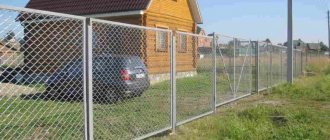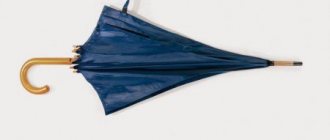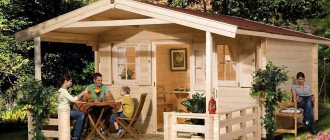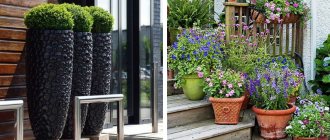DIY clematis support
Creating a support for clematis with your own hands is not as difficult as it might seem at first glance, especially since for its installation you can use improvised materials that are lying around idle at your dacha.
So that you can independently choose the appropriate type of structure, we will offer you several options for supports that even novice gardeners can create with their own hands.
From the grid
If you have a large enough piece of galvanized wire mesh, you can use it to create a simple cylindrical clematis support (Figure 4).
Step-by-step instructions for creating it are as follows:
- As a base, you will need a piece of mesh, which you need to roll into a cylinder and securely fasten the edges with galvanized wire.
- Several thin metal tubes need to be attached to the bottom of the future support. They will act as legs, which in the future can be stuck into the ground and securely fix the support in the selected area.
- The height of the finished cylinder should be approximately 2 meters. Clematis are planted directly next to it, and gradually the vines will completely entwine the structure.
Figure 4. Mesh structures
The only drawback of such a support is the fact that its lower part remains uncovered by flexible shoots. To increase the decorativeness of the flower arrangement, flowering annuals can be planted next to the structure, which will cover the lower part of the mesh and help retain moisture in the soil.
Made from PVC pipes
To make an arched support for clematis, you will need two pipes, about 3 meters long, which will serve as the base, as well as five short tubes no more than half a meter in length, which will later play the role of partitions. Additional materials you will need are welded mesh for PVC insulation, several stainless screws and enamel for the finishing coating of the finished structure.
The step-by-step algorithm for creating an arched support looks like this:
- We bend two long pipes into two identical long arcs. If you cannot give them the desired shape, you can stretch a thick wire inside each pipe and use it to bend the PVC pipes in the desired direction.
- We drive the blanks into the ground at a distance of 20 cm from each other, and short tubes are attached to their base with screws, which will connect the two supports to each other.
- The assembled product can be additionally painted with enamel for additional protection from negative environmental factors. This will also help make it more decorative.
Figure 5. PVC pipes are an excellent material for creating arched structures
In the future, clematis can be planted directly next to such a support, but if you are going to grow several varieties of vines at once, it is advisable to further strengthen the structure with mesh.
To do this, measure two sections of the mesh so that their width is slightly greater than the width of the arch (by about two cells), and the length matches exactly. Along the entire edge of the mesh, protruding rods are formed, with the help of which the mesh is attached to pipe supports. By securely twisting each twig around the pipe, you will receive an additionally reinforced structure that will withstand not only the weight of several clematis bushes, but also strong gusts of wind.
Forged metal supports for clematis, even without flowering vines, can be called a real work of art. It will be difficult to make such a model, since for this you need to have certain skills in working with metal (Figure 6).
Supports made of metal by forging have both advantages and disadvantages. Among the advantages, one should highlight the strength, reliability and durability of the structure, because forged metal, with proper care, is practically not affected by corrosion and is not destroyed by environmental influences. In addition, such supports themselves can be called real works of art, and even in winter, when the clematis are securely covered, they will decorate your site.
Figure 6. Forged models are expensive, but they also look impressive
What support to make for clematis
When looking for photos and ready-made ideas for supports for clematis with your own hands, you need to have a clear idea of what form of trellis will suit a particular variety, and what materials are needed to make it. If you create a carpet composition from a flowering vine, it is optimal to let the plant weave along a mesh or lattice structure that forms a plane. The varieties are selected those whose inflorescences are located from the root to the top, and in the resulting density they create a carpet effect. An excellent example is clematis “Anniversary 70”, as well as “Cosmic Melody”.
To create a cascade, the Turquoise or Climber varieties are well suited. Near the cylindrical supports, varieties are planted for which it is unusual for shoots to cling, for example, “White Dance” or “Alyonushka”.
Important! The support will be covered with clematis only in the warm season. In winter the frame stands bare.
So that it does not spoil the appearance, the structure must initially be assembled with your own hands, neat and attractive.
Clematis in landscape design
To decorate the garden, hybrids are most often used, which do not require shelter for the winter and radical pruning. Every year, landscape designers offer more and more solutions for decorating a site with a variety of clematis:
- Lianas can be used both for vertical gardening and as a colorful carpet on the lawn.
- Some not very tall varieties that do not need support can grow in flowerpots and boxes, decorating verandas, gazebos, balconies and loggias.
- By planting several types of clematis near the arch and intertwining them, you can get a beautiful multi-colored entrance to the garden or plot.
- Soft colors in the background will highlight the personality of the roses, which can be planted in front of clematis.
- Bare tree trunks will look beautiful if they are entwined with flowering vines.
- The original zest of the alpine hill will be given by the lashes of plants that will seem to crawl over the stones.
- Plants with large flowers look most impressive near low walls, in central flower beds, in front gardens and ceremonial places.
- The shady alleys that are located in the background of the garden are decorated with bright, colorful flowers.
But most often, clematis are used to decorate fences, arches, gazebos, hedges, and walls. On hot days, on the veranda or in the gazebo, which is entwined with vines, you can escape from the scorching sun.
It will be useful for everyone to learn about the variety of unpretentious, long-blooming perennial flowers for the garden with descriptions and photos.
Clematis and roses
The growth and flowering conditions of roses and clematis are approximately similar. This is probably why the British love to grow these gorgeous plants together.
However, clematis grow a little faster, so roses are planted first, which will serve as supports for the vines. When planting these plants, you must follow some rules:
- It is better to plant clematis varieties with small flowers to climb roses;
- when planting, the vine needs to be slightly tilted towards the central part of the rose bush;
- plants are planted and cling to supports so that they do not interfere with each other, and each of them is able to enjoy the sun's rays;
- you should choose varieties that have approximately the same height and volume;
- It is recommended to place a partition between the roots of the seedlings;
- Only those roses that are well adapted to the area are planted.
Clematis can simply be planted on the ground between the roses, and over time it will grow around the bushes. Each gardener can independently choose his own combination of colors.
- To make the composition bright, you can add vines with crimson flowers to white roses.
- Pink roses and blue clematis will look tender.
- Vines with purple and violet flowers pair well with yellow roses.
- Red roses will stand out among the delicate buds, and any bright flowers will suit tea roses.
Clematis with other flowers
The neighbors of a lush vine can be:
- coniferous plants;
- black elderberry, fragrant acacia, willow pear, willow, hops;
- Mackerel, barberry;
- buddleia, hydrangea, viburnum, forsythia, spirea;
- grapes, jasmine;
- lilies;
- mock orange
When growing clematis, it is recommended to shade their roots, so calendula, marigolds or other plants with shallow roots are planted around them. Geraniums, irises, astilbes, and phlox look beautiful against the background of vines.
Grape support
Supports for grapes can be made in different ways. For varietal grapes, you can make a simple support from metal pipes.
Another excellent support can be a gazebo made of wooden lattice. The arch from the gate of the site can also serve as a support. When the grapes grow, you will enter your house along a green corridor decorated with bunches of grapes.
How to choose a ready-made design
In gardening stores and large shopping centers you can purchase ready-made supports for climbing plants. When choosing, you should pay attention to the quality of the product - very cheap designs quickly lose their decorative effect and are short-lived. It is also important to find out the possibility of disassembly and assembly on site. Several models of industrial supports:
Several models of industrial supports:
- straight trellis - flat structures welded from a metal rod;
Straight trellis is the most economical store option - trellis with flower pots - a portable support with a box for planting flowers;
Trellis with flowerpots can be installed anywhere - pyramid support - a metal or plastic product in the shape of a cone or pyramid;
The pyramid-shaped support is very easy to install and move - ladder support - a cheaper variation of the trellis;
Ladder support is only suitable for small plants - stake supports made in the form of a tube or spiral;
- garden arched metal structures of various sizes;
Garden arch can have different sizes - pergola - forged or welded metal and wooden products.
This is the most expensive option. Pergolas are most often made of wood
Trellis large and small
In first place, I think, we should put trellises - one of the most popular types of plant supports. Wooden or metal, homemade or purchased, tall or miniature - they are extremely diverse and functional. And of course, they are great for clematis.
Clematis on trellises - a classic option
The design and dimensions of such a support depend on the characteristics of the plant that will have to climb it: compact varieties are suitable for miniature versions, powerful, strongly growing ones will require more impressive ones.
Both support and independent decoration of the landscape
And, among other things, trellises help to zone the territory, hide not particularly attractive objects on the site, and place vertical accents. You will find a variety of ideas for trellises and other types of supports for any garden crops in the collection Please support! Choosing supports for plants .
Types of supports and materials for making them yourself
You can make a support stand for clematis with your own hands using several methods. After studying them, the owner of the site can choose the most suitable one.
Material for making supports
Quite often, when creating flower stands and trellises, materials left over from renovation work are used. Most often used in garden structures:
- wooden slats and boards;
- metal pipes and pieces of fittings;
- plastic mesh or pieces of chain-link;
- old doors and window frames.
Note! After carefully looking at the items stored in the garage or closet, some summer residents create supports from old wheels, furniture parts, fishing accessories, wire, and linen cord. Branches, twigs, and vines are also often used
Wooden pergola
A pergola is a lattice canopy made of slats about 5 cm wide, placed vertically or horizontally. Such partitions are often used to decorate openings in gazebos. It can also be attached to the wall of a building or installed anywhere on the site as an independent structure.
Wooden trellises can have different shapes
Arched metal structure
A metal arch for clematis lasts long enough and is able to withstand the weight of the overgrown lashes of the plant. You can extend the life of such a stand by regularly covering it with a fresh coat of paint or varnish.
Having the skills and welding equipment, you can make the structure yourself. If you lack the skills, it is recommended to opt for a chain-link mesh or a ready-made stand made of reinforcement. Interesting arched supports are widely available in specialized stores.
Tips for beginners
If a novice handmaker takes on the construction of a support for clematis for the first time, you should not mount a structure made of metal pipes, reinforcing rods or chain-link mesh. To perform such work, certain skills are required, the ability to handle professional tools (welding, grinder).
To begin with, it is better to use a garden wooden ladder, making a kind of trellis out of it. You can install an ordinary stepladder in the middle of the flowerbed, which will replace the pyramidal structure. You can simplify the work of assembling a support for clematis by using a bed net from a disused old metal bed. It is enough to make a support, install a part of an outdated bed at a slight angle, placing it vertically or horizontally, and carefully fasten plants strewn with flowers on the surface of the vine.
It is no less easy to assemble a support from wooden blocks, giving it any convenient shape. To work, you will need to prepare a sufficient number of wood screws, a drill and a hacksaw (if the workshop does not have a circular saw).
It is important to remember that clematis will look beautiful if its lashes are evenly distributed and the cells of the structure are small.
When choosing the type and shape of support for clematis, you should take into account the design style of the site. Only in this case will the arch or wall successfully fit into the overall design and the climbing flower will become a real full-fledged decoration of the garden, recreation area or other place in the courtyard of a country house.
Overview of species
Every owner dreams of creating a cozy corner in their garden plot, where they can not only relax, but also hide from the hot rays of the sun. You can create it in different ways, including using clematis placed on supports of various shapes. It is worth considering the most common ones among them and choosing the option that is most suitable for a particular garden plot.
Lattice
The most common and simplest option is a trellis made in the form of a lattice. You can buy it or make it yourself. If we consider the design in general, then the main part of the grille consists of a fairly strong frame. Inside, most often there are figures in the form of rhombuses or squares.
As for the size of the cells, according to standards they should be within 5 by 5 centimeters. These grilles can be installed as a stand-alone structure or attached to a wall. In the first case, the support will need support so that it does not fall from strong gusts of wind. But in this case, the support should also have an attractive appearance and not stand out too much from the general background.
Ball support
Clematis will look very beautiful if a ball-shaped supply is used to support it. In addition, this option is very convenient, because you can install such a support anywhere: in a flower bed, in the garden, and even near the terrace.
Most often, it is made from several curved rods, and its pin legs can be deepened into the ground, which will give it stability. The material used for its manufacture can be metal-plastic or aluminum tubes, which have the ability to bend well.
Support cylinder
With the help of such a structure you can decorate any vertical objects. These can be electric poles or dried tree trunks, which ultimately create the appearance of flowering poles. Their height should be within 2 meters.
An iron mesh can be used as a material for the manufacture of such a cylinder. It must be twisted into a cylinder and secured with ordinary wire. It is necessary to weld reinforcement to it from the sides, and then use them to dig the entire structure into the ground.
Arch
The forged arch looks very beautiful. It can be placed at the entrance to the yard or used to create a place to relax. Most often, such a structure is made from iron pipes or metal. In order to make a semicircle, you will need reinforcement that needs to be bent. The arch should be high and wide. This is necessary so that both a table and chairs can fit under it. Around such an arch you need to plant several clematis bushes. The composition will look very beautiful if the flowers have different shades.
Pergola support
It is a horizontally or vertically installed canopy, which is subsequently braided with clematis. Most often, a pergola is made from very thin wooden planks. This could be one or more broken frames. It can be placed on the site either as an independent structure or near a wall.
Obelisk support
Many gardeners call structures made in the form of pyramids obelisks. They are made from iron rods or wooden planks, which are fastened together with special crossbars, as a result of which they are very stable. You can install such structures in the most unusual places, for example, in flower beds, in the garden or even near the terrace.
Support with cord
It can be made from ordinary ropes or dense threads that are quite capable of supporting the weight of a clematis bush. Such supports have some advantages. For example, when you need to prune, the vines can be easily removed from such supports. After all, they will slide off without much effort and will not be damaged.
Trellis support
This design is the same trellis, made in the form of a lattice. Its only difference is that it consists of several sections. The most popular option among gardeners is the design that is made of 3 or more sections. Each of them is collected separately. The cells of the central section are made in the form of rhombuses, but the side ones are made in the form of squares of the correct shape.
All these sections must be connected to each other into one wall. Above the middle pillar you need to install a small semicircle that will look like sun rays. The trellis must be carefully secured in the ground using guy wires, which must be very strong. After all, such a structure, together with flowering clematis, will weigh quite a lot.
Beautiful supports for roses
Every gardener wants to decorate his garden with flowers and ornamental plants. Roses of different varieties are very popular. The climbing variety of this plant looks very beautiful. So that it does not take up much space, you need to take care of the support in advance. And of course, the support should be beautiful. We list five beautiful supports for roses:
Obelisk.
Umbrella support.
Pergola.
Garden sculpture.
Forged screens.
Obelisks made of slats, bars, fittings or branches
The pyramidal supporting structure, called (in accordance with its geometric shape) obelisk, is very popular among fans of growing clematis:
- Firstly, it is quite easy to make it yourself.
- Secondly, a variety of materials can be used for construction (bars, slats, rods, fittings, metal tubes, and so on).
- Thirdly, it is easy to install (simply by sticking it into the ground) in any part of the site, and if necessary, rearrange it (for example, when the soil is depleted and the clematis needs a new place to plant).
An obelisk made of willow twigs, shaped like the frame of an Indian wigwam, will look good on your site even after the clematis has faded.
Original solutions
Well, to conclude the selection, there are ideas for unusual supports that are difficult to classify into any specific category. Perhaps they will prompt you to search for your own non-trivial solutions:
Unusual, isn't it?
In my opinion, this is a good reason to look into the “bins”, where the thrifty summer resident has just about everything... Now you know where you can put, for example, rusty metal wheels from some equipment that have been lying around in the barn for a long time:
There's no need to reinvent the wheel, but you can find unexpected uses for it
Do you have clematis growing in your garden? What supports did you make for them? Tell us, share photos!
How to make a support for clematis
It is not necessary to buy supports for clematis, since you can make any design with your own hands according to the drawings, and interesting ideas and photos will help you figure out how and in what sequence to make such a product.
Simple support
The simplest option can be made from a plastic mesh intended for tying cucumbers, flowers, or from a chain-link with a mesh size of 10 cm. The mesh is stretched between two supporting elements, which can be made from reinforcement or pipe sections.
It’s even easier to create a support by stretching several rows of rope between the posts.
Made from metal mesh
This option is more complicated than the previous one, but its strength is much higher. To make it you will need a mesh with large cells and wire for knitting.
The installation process itself is as follows:
- A cylinder is formed from the mesh.
- The joint is connected with wire.
- Several reinforcement bars are buried and a mesh cylinder is attached to them.
- Clematis are planted inside or outside the structure.
Trellis
The most complex support is a lattice attached to the wall. However, the complexity is fully justified by the beauty of the design. A wall trellis is best made from 1x4 cm wooden slats, but the frame will require thicker slats.
When designing, you need to ensure that the size of the cells is the same. This is necessary so that the vine branches pass through them freely.
The manufacturing process boils down to assembling a frame from bars, followed by stuffing the slats and forming cells of 5-20 cm. The shape of the trellis can be either rectangular or fan-shaped. The finished structure is attached to the wall of any building. The height of the trellis can be up to the roof. A support made of several tiers looks best.
Arched design
The product in the form of an arch can be made of plastic pipes or fittings.
In the first case, the design is much simpler and consists of the following steps:
- An arc is formed from two long pieces of PVC pipe.
- The ends of the blanks are buried in the ground with a distance between elements of 25-50 cm.
- Both arches are connected to each other by attaching short tubes to self-tapping screws.
- To give an attractive appearance, the entire structure is painted in the desired color.
If reinforcement is selected for assembling the support, then the work becomes somewhat more complicated. First, you need to dig into the ground, or better yet, concrete 4 small-diameter pipes. A frame is constructed from reinforcement, connecting all elements by welding. The finished arch is placed inside the pipes and welded.
Reinforcement is also used to form cells. All elements are secured using a welding machine. After completing installation, the product is coated with paint. This will protect the metal from corrosion and give the structure a more attractive appearance.
Pergola
Supports for clematis in the form of a pergola look very nice, and you can find out how to make it with your own hands from the photos and drawings.
Ideas for such a design can be different, but most often the height is no more than 2.5 m. The structure looks quite attractive and can decorate any garden just with its presence. The material for making a pergola can be a plastic pipe or wood. Which option to choose is up to everyone to decide for themselves.
Installation of the structure begins with the burying of support pillars into the ground, for example, from a 60x60 mm profile pipe. For them, you need to prepare holes about 50 cm deep, and then perform concreting. Then beams are placed in the pipes, to which wooden slats are secured.
The pergola design can be customized to your liking. Clematis are planted on the sides of the structure, and over time they will grow throughout the entire support.
From the bushes
Shrubs growing on the site can also serve as a holder for clematis. These are lilac and forsythia. The flowering of lilacs is short-lived, and the vines will envelop the bush and delight the owners with their beautiful flowers. However, to ensure that clematis does not interfere with the development of the supporting bush, you need to monitor and promptly direct the climbing branches in the right direction.
From the twigs
Such a structure will attract attention even after the clematis has finished flowering. For construction, willow branches and thicker rods are used, which will serve as a frame.
The branches are sharpened and inserted into the ground at the site where the vine is supposed to be planted.
Circles are woven from willow, connecting poles together into a single structure. You can choose any pattern for weaving. After installation is complete, you can begin planting clematis. When the shoots grow, they are supported.
How to tie flowers to a support correctly
If the support has not yet been erected on the site, then begin installing it yourself before planting the clematis. When the planted vine puts out its first shoots, they are immediately wrapped around the horizontal lower element of the trellis. Growing stems are gradually guided along vertical slats and help to catch on to higher horizontal bridges.
If clematis is not able to firmly fix itself to the support, the stems are constantly tied with fishing line as they grow. It is not advisable to use wide ropes made of fabric, as they spoil the appearance. The stems are arranged evenly along the trellis in a fan, do not allow them to intertwine.
How to tie clematis so that it curls beautifully along the support
Knowing how to tie clematis to a supporting partition, you can create a very beautiful corner on your site. An incorrectly tied plant will overload the structure and develop poorly.
How to tie flowers to a support correctly
The vine lashes should be evenly distributed over the entire support and tied. The shoots should be arranged in one layer, without overloading the trellis
It is important that all parts of the plant are well lit
Important! It is recommended to use twine as a garter material.
Clematis on a support can decorate any garden building
Before planting climbing vines - climbing roses or clematis, you should carefully consider what they will rest on when they actively begin to grow. In adulthood, such plants reach impressive sizes, and the lack of reliable support can affect their condition.
vote
Article Rating
Shall we decorate the porch with clematis?
Don't want to risk the walls of your home? What do you think about the idea of placing clematis on the railings and porch posts?
Why not add clematis to your porch?
Such floral decor will certainly decorate the front area. True, when the vine grows, difficulties may arise: there is nowhere for the clematis to grow, and it is inconvenient for you to use the railings. Therefore, it is better to choose relatively compact varieties for planting near the porch, so that later you do not have to make your way into the house through lush thickets.
Grates and nets on the walls of buildings or fences
Using the supporting structures of various buildings located on the site as hand-made supports for clematis is an idea that does not claim to be new or original. This method has long been used successfully by many gardeners. The popularity of this method is explained by:
Simplicity of arrangement. It is enough to fasten a grid of slats, a metal mesh or ropes (cords or wire) to the wall.
- Reliability and high strength (which the load-bearing structures of buildings initially possess) of equipped supports.
- The ability to give very dull walls (for example, made of brick or concrete) an attractive appearance (at least during the flowering period of clematis).
With the help of flowering plants, you can decorate not only the external surfaces of buildings, but also, for example, the supports of country balconies or external terraces.
And just a fence surrounding the perimeter of the area, for the manufacture of which many summer residents use a metal mesh, is a ready-made and durable supporting device for growing clematis.
Clematis + fence = ...
A wonderful combination: the fence serves as a reliable support for the clematis, which, in turn, decorates even the most unprepossessing hedge and covers the area from prying eyes (when it grows, of course).
The fence of your site can serve as a support for clematis
And it doesn’t really matter to him what kind of fence you have: an old wooden one, a stylish wrought iron one, a powerful concrete one or a budget one, made of chain-link – as long as there is something to cling to.
Clematis doesn't care what kind of fence you have - it would have something to cling to
Making a support for clematis
Wicker support made of twigs
This is the type of support that looks impressive even without the presence of a vine. To build it you will need an axe, willow twigs (you can replace them with vines), twine and several high perches.
Trellis made of beams
- To create an interesting trellis you will need slats and bars with a thickness of 5 cm.
- The frame itself is made up of beams, and slats are laid out on it as a lattice. In this case, the horizontal ones are superimposed on the front side, and the vertical ones, running perpendicular to the first, on the reverse side. It is advisable to fix them with self-tapping screws, so the structure will be stronger. This is especially true for the intersections of slats.
- In the place where the trellis will stand, it is necessary to secure the support pillars. If this place is near the path, then the trellis is additionally reinforced with metal corners. In the same way, the trellis itself is attached to the pillars.
- For maximum reliability, it is better to build additional supports. So, a trellis located close to the wall of the house is supported on it with auxiliary beams.
Chain-link mesh support
One of the simplest, but no less interesting, methods is to create a support for clematis from the most ordinary chain-link mesh. To create it, you will not need any expensive material or special effort; this support is simple, economical and at the same time effective.
Clematis looks interesting growing near a fence and stretched over a volleyball net. The lower part of the mesh is secured to stakes driven into the ground, and the upper part is attached to the fence using hooks or bent nails.
Arch for clematis
The arch can be called the most beautiful design for climbing plants. Ready-made options sold in stores undoubtedly amaze with their variety, but their cost is not affordable for everyone. Therefore, many craftsman gardeners make arches on their own.
To make them you need a pair of long three-meter duralumin tubes, 5 pieces half a meter long, welded mesh in PVC insulation, stainless screws and enamel.
Support for cucumbers
It is best to grow cucumbers in a vertical position. This allows you to quickly and efficiently harvest the crop, and also eliminates unpleasant sensations on the skin. Various hangers can help with this. They can be made of wood. For example, from timber and slats you can build a support - a pyramid. It won't take up much space.
You can also install poles on both sides of the bed and stretch a mesh between them.
Or do it differently, we put up a pole and plant it around it and tie twine to it. After this, we secure each rope to the ground with small pegs. The distance from the post to the rope is 60 cm. After this, we plant cucumbers. As they grow, they will trail along the twine.
Features of growing clematis
Thin vines strewn with many beautiful flowers are welcome guests in many areas. Blooming at the beginning of summer, they are able to delight with amazing flowering throughout the season.
Large-flowered varieties, capable of covering an area of up to 4-5 meters, act as an elegant decoration for the front areas of the site: the walls of the veranda and gazebo, the central entrance and front garden
Small-flowered varieties of clematis are excellent for shading the facades of buildings, grottoes, stairs and unsightly buildings.
A clematis hedge, like a woven dense carpet of thousands of marvelous flowers, can not only transform an area, but hide it from the prying eyes of passers-by
Clematis are plants that prefer sunny areas, but require shading of the root system, in simple words “head in the sun, and feet in the shade.” The second no less important condition for growing these beautiful flowering plants is placing them on supports. Properly selected supports for clematis will allow you to give the compositions the desired shape and demonstrate the decorative qualities of the plant.
Clematis most often act as the center of vertical gardening design. When choosing plants to decorate a site, it is advisable to take into account the biological characteristics of a particular variety. If you want to create falling “cascades” or elegant “garlands,” it is better to opt for varieties whose flowers are more concentrated at the ends of the shoots, for example: Serenade of Crimea, Biryuzinka, Alpinist. When decorating “carpet” compositions, it is better to give preference to varieties whose flowers are evenly distributed along the vine: Cosmic Melody, Alyonushka, Gray Bird.
Types of supports for flowering clematis
Depending on the shape of the support for clematis, there are:
- Arched;
- Pyramidal;
- Fan designs.
The main requirements for them are: decorativeness, ease of installation and ease of use. Thanks to the supports, the clematis stems do not break or trample. Using vertical stands, you can provide ventilation to plants, which is the key to their rapid development and abundant flowering. An arch is the most common type of garden support for beautiful flowering plants.
A support entwined with flowering clematis, in addition to being an elegant element of decorating any garden, helps to divide the space into separate functional zones
The arch entwined with clematis, installed at the beginning of the path, looks simply amazing. She seems to invite you to stroll along the winding paths of the garden and immerse yourself in its enchanting beauty.
Clematis also feel comfortable on pyramidal tripods made of reeds, or metal or willow rods.
Pyramid supports provide good support for the flexible stems of the plant. They look appropriate both in multi-tiered flower arrangements and as a free-standing structure
You can create a cozy, romantic corner in the garden, where you can retire on a hot afternoon or a cool evening, hiding from the prying eyes of passers-by and enjoying the enchanting beauty, with the help of trellises.
Support material
A support for clematis can be made from a wide variety of materials. It is permissible to use unnecessary residues after repairs. What material can you take:
- wooden parts (slats, boards);
- untreated wood (twigs, vines, branches, etc.);
- metal parts (pipes, fittings);
- various types of mesh (metal mesh, plastic mesh);
- materials with good flexibility (wire, cord, fishing line);
- old doors and windows;
- various unnecessary parts (wheels, crib parts, etc.).
We invite you to familiarize yourself with Braga made from sugar and yeast for moonshine - in questions and answers
Types of supporting structures
To understand how to make a support for clematis with your own hands, you need to study several options for these structures. Each type of support has its own advantages.
- Metal supports for clematis are more demanding and difficult to produce. After all, their production requires skills in working with a welding machine.
- Wooden trellises or mesh stands are an alternative option for those people who do not know how to work with metal.
There are several popular types of clematis supports.
Metal grid
It lasts a long time and is reliable. You can make a trellis from reinforcement and mesh. The main material can also be wooden blocks. The garter to such a support must be fanned out so that the flowers of the plant are evenly distributed over it.
Rope support
Made from plastic pipes, various cords or ropes, a bicycle wheel and wire hooks. The main advantage of this design: clematis is easy to prepare for winter. To do this, you just need to remove the ropes. Then you can immediately begin preparing the plant.
Arch
It is made from a plastic pipe and a rope trellis. The edges of the pipe, bent into an arc, are installed on reinforcement buried in the ground. Since people will be moving under the structure, it must be of an appropriate size. The vault can be made in various shapes.
Tripod
This design is used not only as a support for clematis, but also for marking it. Wooden slats or metal rods can be used as materials for making a tripod. Such a structure can become a decoration for a summer house, especially if there is no house wall or gazebo.
Support made of wooden planks
It makes it possible to implement original ideas, for example, bars on the wall of a house. However, such a structure has a short service life. Moisture accumulates under the plant, causing the tree to rot and the structure to lose its strength.
Keep in mind that a support made of thin rods will be too fragile.
Forged support
Using forged parts, you can create many different options for supporting structures. Such a structure will be a decoration even in the cold season. A forged support will not be cheap. You cannot make a support from such materials yourself without special skills and experience, so you will have to buy it.
What kinds of supports are there for climbing plants in the garden?
Support structures for clematis can be very diverse.
Form options
They can be very diverse:
- trellis is the most common option, which is a lattice with a cell size of about 5–6 cm. It requires reliable fixation, as it can fall from a strong gust of wind (if it stands separately);
Most often, a trellis is made for clematis - arch - installed above the entrance, garden path, path, etc. Visually divides the space;
An arch with clematis looks extremely decorative - pergola - a canopy made of several frames located in vertical and horizontal planes;
Pergola with clematis is often used in garden design - decorative figures - Most often a pyramid (obelisk), a ball, a cylinder, but any fantasy shape is possible (jug, star, mushroom, etc.).
The support for clematis can be of any fancy shape
Ideas for production materials
The support can be made from a variety of materials:
- wood - any structures are made from wooden blocks and planks, but they do not last long and quickly lose strength;
- metal is a very durable and strong material that holds its shape well, but is quite expensive and requires professional skills in manufacturing and installation;
- plastic is light and inexpensive, but fades in the sun and is not strong enough;
- flexible materials (cords, ropes, wire, fishing line, etc.) - have a low cost, are quickly installed, but almost always last only one season;
- improvised means and all sorts of rubbish (cart wheels, headboards, old bicycles, etc.) - free, original;
- unprocessed wood materials (vine, bamboo, branches, etc.).
An arch made of twigs fits harmoniously into the landscape
Why do flowers need trellises?
A support or stand for clematis is simply necessary, because this plant belongs to the climbing class. The length of clematis vines or vines can reach several meters. At the same time, the stems of the flower are thin and herbaceous - they cannot independently support their own weight, not to mention the mass of leaves and flowers.
Supports for clematis are needed for several reasons:
- Lianas of flowers, beautifully arranged on a support, look much more impressive and aesthetically pleasing than vines growing on the ground.
- Vertical gardening is one of the hottest trends in modern landscape design. Not a single trendy style can do without this technique.
- Support for clematis itself is vital, because in a vertical position the flower will be evenly illuminated by the sun and properly ventilated. Rot and fungus, snails or slugs will not appear on the leaves and stems.
- Caring for a plant attached to a support is much more convenient and simpler: access to the roots is not difficult, it is easy to apply foliar fertilizing and carry out preventive spraying of climbing flowers, and pruning the bush is not difficult at all.
- Beautiful supports themselves become a real decoration for the garden. Although clematis bloom throughout the warm season, in winter the area should also look aesthetically pleasing.
We invite you to familiarize yourself with Growing broilers - features, payback -
Attention! There are a lot of different supports, arches and trellises for climbing plants on sale. But it is much more profitable to build supports for clematis with your own hands, using available building materials.
The support for clematis can look like anything - there are no specific standards here. As for where and how to secure the vines of flowering clematis, each gardener will have his own options and methods. Here are the most common and popular ideas:
- blank walls of various buildings on the site (residential building, sheds, veranda, utility rooms);
- poles used to protect or secure various communications (lights, electrical wiring ducts, water pipes, etc.);
- window and door openings in a residential building, on the veranda, in the gazebo;
- lattice walls or roofs of summer gazebos, pergolas, arches;
- free-standing stands for clematis or other climbing flowers, which can have absolutely any shape and design complexity, and are made from various materials;
- fences and hedges surrounding the site.
Where you can plant clematis is now clear, all that remains is to decide how to secure the flower vines in the right place. In order for the clematis lashes to take the desired shape and grow in a given direction, special support is needed. The growing shoots of clematis will be attached to the elements of the support or arch with special staples.
Important! Clematis grows very quickly - you will have to fix the elongated shoots two to three times a week.
You can make a trellis for clematis with your own hands from absolutely any material. There is absolutely no need to spend money on buying new building material; improvised materials, leftover parts from repairs or construction, and even unnecessary rubbish are also suitable for the job.
The material for making the support for clematis can be any:
- wooden lumber (slats, bars, boards);
- untreated wood (willow twigs, branches, vines, bamboo);
- metal profile (pipes, fittings, corners);
- various meshes (metal mesh, plastic meshes, polyurethane-coated structures);
- flexible materials (metal wire, nylon cord, fishing line, twine or rope);
- old paneled doors or window sashes (the glass must be removed from them first);
- various rubbish that can be found in every household (backrests from playpens, spring nets from beds, rusty bicycles, wheels from a cart - whatever!).
Grape support diagram
The scheme greatly simplifies the work of constructing the support. You immediately see the dimensions and can calculate the amount of materials. The diagram below shows the dimensions, namely the height is 2.2 m and the distance between the pillars at the ground is 87 cm. It increases upward. The planting of grapes is also shown. Looking at the diagram, you can clearly imagine how the entire structure will look on the site.











